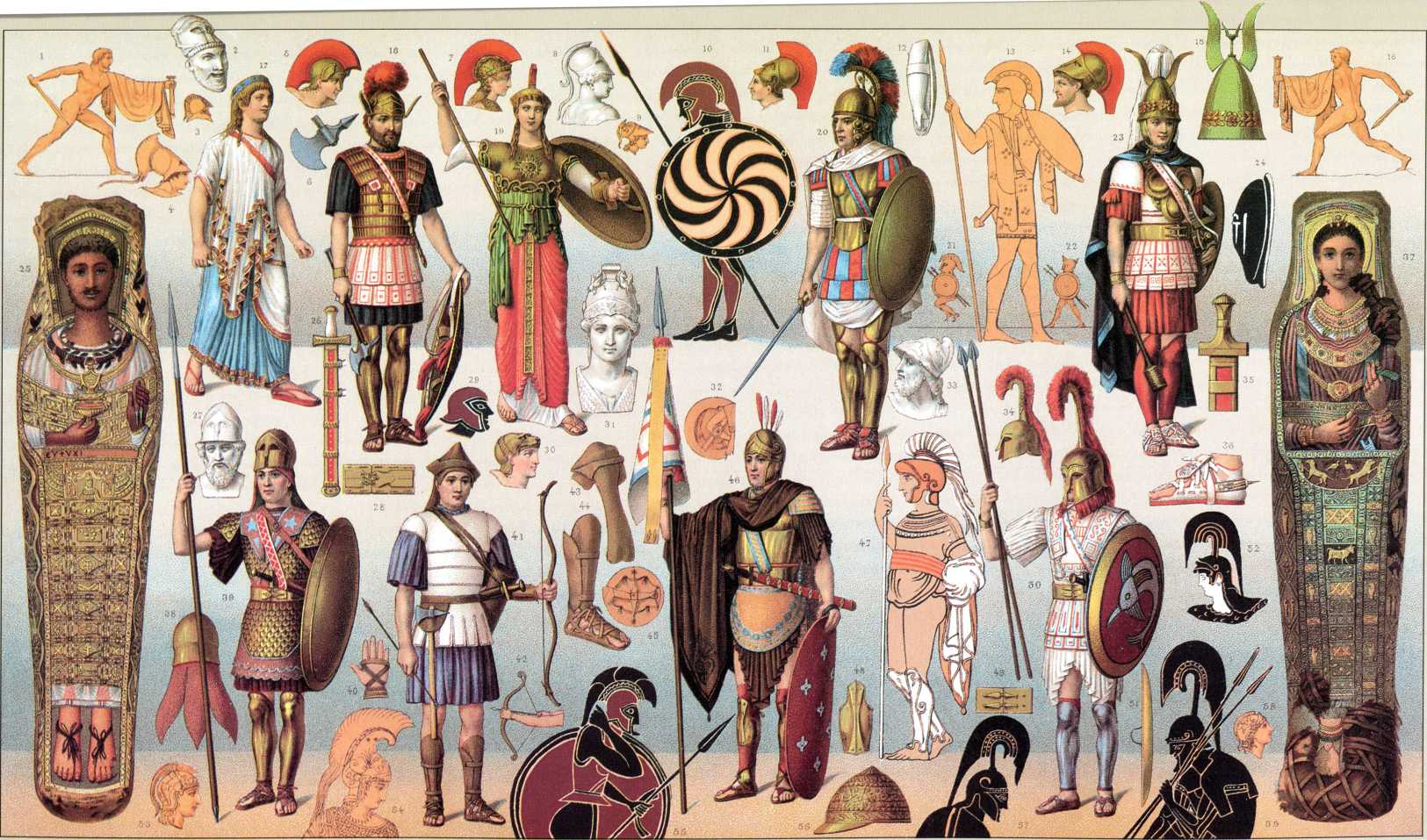|
|
THE HISTORICAL ENCYCLOPEDIA OF COSTUME
ALBERT RACINET
THE CLASSIC WORK OF THE 19TH CENTURY
THE ANCIENT WORLD
THE HEROIC AND HISTORIC AGES
THE DIFFERENT AGES OF GREEK MILITARY COSTUME can be distinguished by the dimensions, if not the type, of the weapons carried by the Greek soldier. Large shields from Argos, javelins and short swords are of the age called "heroic". With the "historic" age came a reduction in the size and weight of shields and an increase in the length of javelins and swords to twice the size that they had been previously.
18 An officer, whose armour is made from pieces of bronze held together by leather-covered ropes and lengthened by a double lambrequin, also made of leather. The under-garment is a short-sleeved woollen tunic.
He is wearing a low, rounded helmet with the visor and leather chin straps drawn up and a red plume like a fan. His baldric is made of leather and his sword has an ivory handle (26). His shield is round and convex, made from two pieces of wood with an ornamental bronze plaque. Inside it are red tassels (48).
This picture is taken from a vase-painting that shows the combatant's arm reaching through one handle to hold on to another, thus enabling him to manoeuvre the shield with more dexterity.
20 A heavily armed infantryman, an hoplite, wearing a bronze helmet with a strong, wide chin strap of the same metal, an ornamental crest and a plume of horse hair.
5, 10, 29 & 55 Helmets of the heroic style with rounded casques, no visor and tall crests. The exception is 29, where the crest has been removed as a mark of defeat.
1 & 16 confirm the theory that the Greeks carried a cloak on their left arm if they did not have a shield.
21 & 22 Illustrations from a vase showing soldiers marching.
50 A peltast, a light infantryman. The pelta, a name first given to a small shield by the Amazons, was made of wood or of wicker-work covered with leather. 49 shows in detail the double clasp of his belt and 34 shows his casque with its high plume; see also 52, 57 and 59.
23 A cavalryman, who would have ridden without stirrups, probably with just a piece of cloth on the horse's back. He has three protective discs of bronze on his cuirass, and leather leggings. He is carrying a sword (detail in 35) and spurs are attached to his sandals.
39 A phlangite - so called because he fought as part of the phalanx formation - wearing the helmet of Minerva. This was a leather headdress with three tails of leather covering the back of the neck (38). His one-piece cuirass is made of bronze and fastened at the waist by a bronze belt (28).
46 A victorious soldier. Pinned to the top of his lance are the cuirass and belt of his vanquished enemy.
41 An archer wearing a leather hat with a neck-covering that falls a long way down his back (43) and leather leggings (44).
19 The goddess Pallas Athena, armed with a golden lance and an aegis.
17 Diana the Huntress.
40 A hand clad in a coestus. This consisted of straps of leather twisted around the hand, sometimes as far as the elbow, whose purpose was to help the boxer in hand-to-hand combat.
25 & 37 Mummies of a civilian man and woman. Mummification would have taken place in Egypt.

A larger image of Greece - The Heroic And Historic Ages, showing soldiers, arms and armour by Racinet.
Other Ancient Racinet Prints: Etruscan, Britons & Gauls
Index of Racinet Prints
Ancient Illustrations & Articles
|

